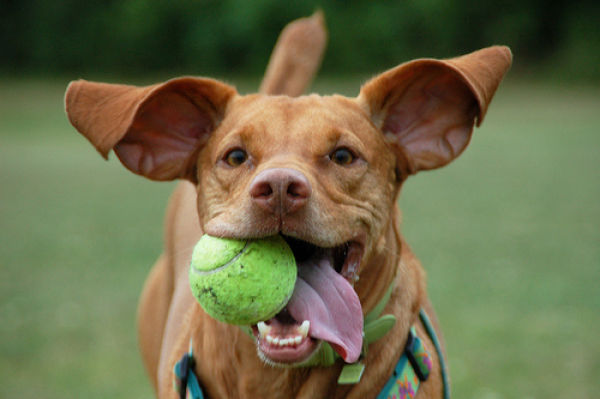Before we get into anything to do with balls, I want to explain the method of training I'm using.
The method we use in flyball is called backwards chaining, and this is where you start at the end and work your way to the front or in this case we start with the dog running back to you and work our way to where you send the dog for the ball. Now, you may be somewhat confused by what I just said, but don't worry, you will begin to understand as I take you step-by-step through this process.
Now, I know I said that we work backwards which means, like I said, I should be showing you how to work your dog on running back to you, but think about it for a second. When the dog is running back to you, what does he have? A ball! Your dog is bringing the ball to you, so we need to make sure that your dog can do this before we work on anything else.
Okay. So let's get started. The first thing we start with is your dog and a couple of tennis balls or racket balls, or whatever ball works the best with your dog (squeaky balls are not allowed in competition). I would recommend doing this activity outside, so you don't break anything.
The next thing we are going to do is get our dog into a sit and make sure to get his attention. Gently toss the ball at his mouth. The goal, of course, is for the dog to catch the ball. If he does then praise him, even if he catches it and immediately drops it. I would treat him too even if your dog normally just accepts praise. Try this for about 5-10 times and if he continues to catch it then it's time to move him on to the next step.
No the next step is not doing jumps. Be patient. Flyball takes a lot of time and patience in order to train a dog to exceed. The next step is to start throwing the ball higher over his head and watch him jump to get it. Even if he still sits there, that's ok too, just make sure he catches it. Once your dog is doing this about 100% of the time, you can start the next step which is bouncing the ball.
Now you may wonder, "Why are we teaching them to catch a bouncing ball?" It's because, sometimes when a dog hits the box and the ball comes out, it will, at times, hit the dog's mouth and bounce off. The ball might roll away or bounce somewhere. If this happens, you want your dog to be able to get the ball back the fastest way possible. If it's rolling, then your dog will probably just chase it down and grab it. To me, that is probably the fastest way, but if it's bouncing, the fastest way for him to get it and get it back to you is for him to catch it on a bounce. You might also be thinking, "Well, my dog can do that?" But you need to ask yourself, "Can he do it 100% of the time, without the ball hitting his teeth and bouncing even farther away?". Yes, I expect my dogs to be able to do this, but I train them for it and practice with them on it. I'm not saying they can preform this task 100% of the time, but they don't get rewarded if they don't. So here's how to do this.
Start with your dog in a sit and bounce the ball lightly so it comes up about eye level on him. If he catches it, then reward him and repeat again about 5 times. Gradually work to where you're bouncing it about 10 feet high. Don't reward him unless he catches it without it bounces off his teeth. Once your dog can do this, start bouncing the ball away from him. Let him chase it but only praise him if he catches it on a bounce.
After your dog can perform this task fairly well, then you can move on, but make sure to practice this every once in awhile to make sure he doesn't get rusty.
I certainly hope you enjoyed learning how to do this. I hope to one day have videos of me training my dogs to do this so you will have something more to go on. But if you have any questions or need help with a problem your dog is having then just post a comment and I'll try to help you out.
Hope you all have a wonderful day and remember, training is meant to be fun. Train Away!!!
NEXT: How To Train Your Dog For Flyball: Part 2 TUG TIME



No comments:
Post a Comment